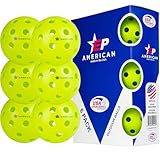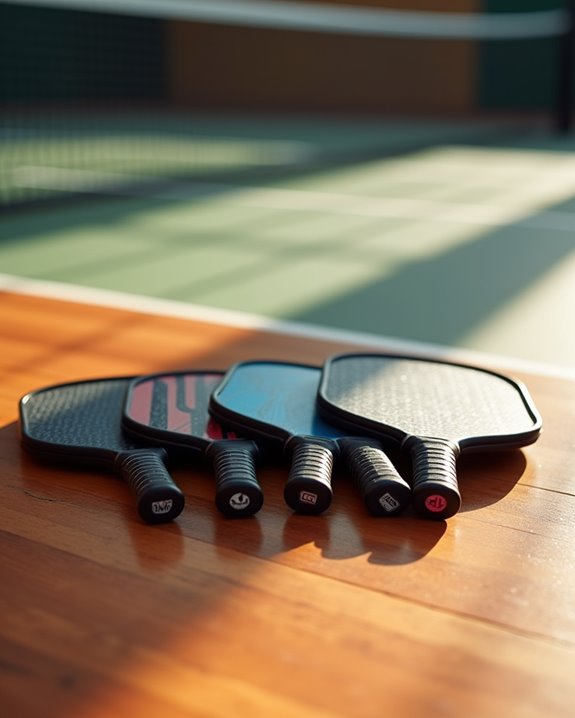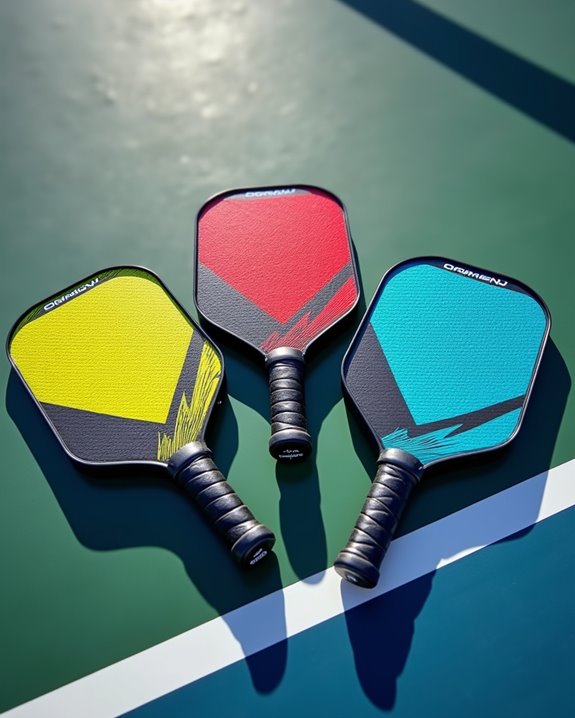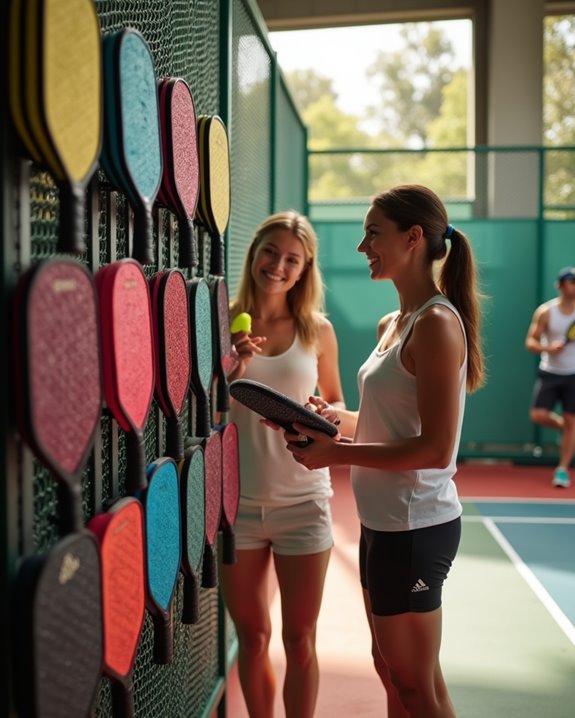As an Amazon Associate, we earn from qualifying purchases. Some links may be affiliate links at no extra cost to you. Although our opinions are based on curated research, we haven't used these products. Articles generated with AI.
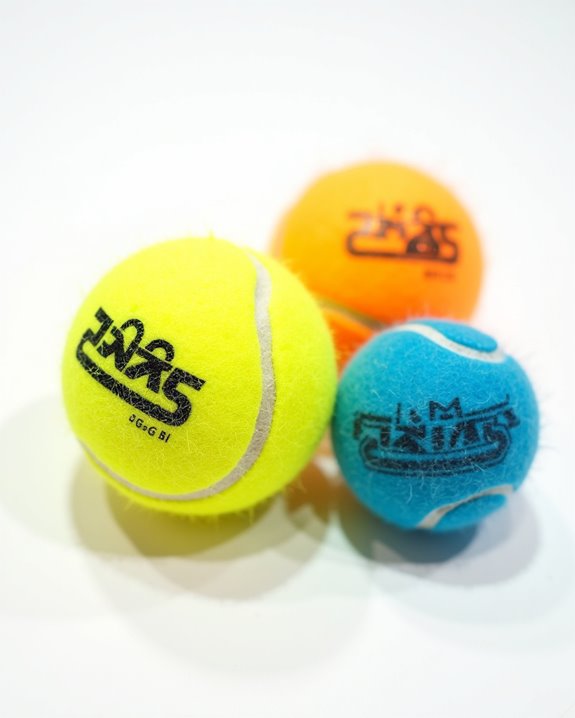
3 Best Pickleball Balls X
The top three pickleball balls for consistent performance are the X40 USAPA Approved (tournament-quality with 40 precision holes), Selkirk Pro S1 (featuring patented 38-hole design and rotomolding technology), and EP American Outdoor Pickleballs (American-made with exceptional durability). You’ll notice these USAPA-approved options deliver predictable flight patterns, reliable bounce, and crack-resistant construction that withstands intense play. Each ball’s unique hole pattern affects spin control and visibility during matches. Discover how these subtle differences can elevate your game.
Key Takeaways
- X40 balls are USAPA-approved with 40 holes for balanced flight and consistent bounce in all weather conditions.
- Selkirk Pro S1 offers a patented 38-hole design with seamless rotomolding technology that enhances spin precision.
- EP American Outdoor Pickleballs feature 40 precision-drilled holes and exceptional durability on rough outdoor surfaces.
- The best pickleball balls maintain visibility with bright colors and consistent performance across varying temperatures.
- USAPA approval ensures tournament-legal equipment with consistent flight patterns and reliable bounce characteristics.
X40 USAPA Approved Outdoor Pickleball Balls
No products found.
If you’re serious about your pickleball game, whether you’re serving up your first shots or smashing winners like a pro, the X40 Outdoor Pickleball Balls deserve a prime spot in your equipment bag.
These USAPA-approved balls are the official choice of the U.S. Open Championships, featuring 40 precisely drilled holes that deliver a perfectly balanced flight – like a perfectly risen soufflé of pickleball perfection. You’ll notice the consistent bounce and predictable trajectory with every swing.
The one-piece construction stands up to intense rallies, maintaining its crisp performance even in cold weather. Their bright yellow color guarantees visibility when you’re dishing up those final points at dusk.
Best For: Dedicated pickleball players of all skill levels seeking tournament-quality balls with consistent performance and durability for outdoor play.
Pros:
- USAPA approved and tournament-grade with precise 40-hole design ensuring balanced flight and reliable trajectory
- One-piece construction delivers exceptional durability and maintains performance across various weather conditions including cold temperatures
- Bright yellow color enhances visibility during play, especially in low light conditions
Cons:
- May wear down faster when used on rougher asphalt surfaces
- Some customers have reported packaging issues, receiving fewer balls than expected
- Premium quality comes with a higher price point compared to recreational-grade pickleball balls
Selkirk Pro S1 Outdoor Pickleball Balls (USAPA Approved)
Selkirk Sport Pro S1 Ball | Crack-Resistant | 38 Hole Outdoor Pickleball Balls | USAPA Approved...
- 【 Cutting-Edge Design 】 The Pro S1 Pickleball Ball introduces a revolutionary cutting-edge patented design that guarantees consistent flight, bounce, and unmatched...
- 【 Precision Craftsmanship 】 Unlock unmatched consistency with the Pro S1, empowering players with a precise feel off the paddle face. Gain the confidence to execute...
- 【 Exceptional Durability 】 Years of development have led to the Pro S1's seamless rotomolding technology, creating a perfectly round and balanced ball. This advanced...
Serious tournament players who demand precision will find their match in Selkirk Pro S1 Outdoor Pickleball Balls. The patented 38-hole pattern delivers consistent flight—like a perfectly tossed salad maintaining its form mid-air. You’ll appreciate how they maintain their shape in various conditions, thanks to seamless rotomolding technology.
With a 4.6-star rating from over 1,400 players, these USAPA-approved balls offer excellent performance. They’re especially crisp in cooler weather, though they may stiffen in summer heat. The 1-year no-crack warranty adds peace of mind, though some users report earlier cracking. While pricier than competitors, most enthusiasts find them worth the investment. Buy in bulk for better value.
Best For: Competitive pickleball players and tournament participants who prioritize consistent ball flight and precise gameplay in cooler weather conditions.
Pros:
- USAPA approved with patented 38-hole design that ensures consistent flight and bounce
- Seamless rotomolding technology provides excellent feel off the paddle and enhances spin precision
- Comes with a 1-year no-crack warranty for peace of mind
Cons:
- Higher price point compared to competitor pickleball balls
- Some users report cracking issues before the warranty period ends
- May become too rigid and less responsive in hot summer temperatures
EP American Outdoor Pickleballs (USAPA Approved)
EPAMERICAN Outdoor Pickleballs USAPA Approved | Made in USA with Durable Design | Tournament-Ready,...
- SUPERIOUR OUTDOOR PERFORMANCE: EP American Pickleballs are designed specifically for outdoor play, providing unmatched consistency and quality on all surfaces. Their...
- PRECISION FLIGHT & SPIN CONTROL: Engineered with 40 (8mm) precisely drilled holes, EP American Pickleballs offer a perfectly balanced flight pattern and tight,...
- USAPA APPROVED: Our pickleballs meet the strict specifications required by USA Pickleball for official tournament play, including exact size, weight, and performance...
Tournament players seeking professional-grade equipment will appreciate the exceptional quality of EP American Outdoor Pickleballs. Made in the USA, these USAPA-approved balls are crafted with 40 precision-drilled 8mm holes that serve up balanced flight patterns and predictable spin—exactly what you need for shot control.
You’ll notice these balls maintain their consistency like a perfectly simmered sauce, performing reliably in both recreational volleys and competitive matches. Their durability is exceptional; they won’t crack or lose their bounce on rough outdoor courts. With a stellar 4.8-star rating, players rave about their excellent spin control and visibility—not too bright, but easy to track during play.
Best For: Serious tournament players and recreational enthusiasts who demand USAPA-approved pickleballs with superior durability on outdoor courts.
Pros:
- Made in the USA with 40 precision-drilled 8mm holes for consistent flight patterns and predictable spin
- Exceptional durability that withstands rough outdoor surfaces without cracking or losing bounce
- Highly visible without being too bright, making them easy to track during gameplay
Cons:
- Premium price point compared to non-tournament grade alternatives
- Limited to outdoor play specifications, not ideal for indoor courts
- Only available in 3-pack quantities, which may not be sufficient for frequent players
Factors to Consider When Choosing Pickleball Balls X
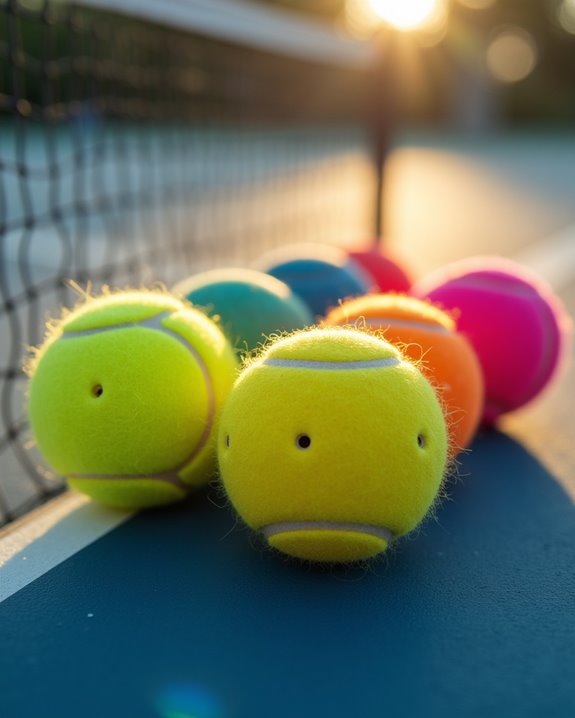
When you’re shopping for the perfect pickleball balls, you’ll need to take into account several key ingredients that affect performance just as essential components transform a recipe. You’ll want to check USAPA approval status, determine whether you need indoor or outdoor balls, and examine hole pattern designs that influence flight dynamics. The durability in harsh conditions and consistency in bounce will ultimately determine if your pickleball experience feels like a perfectly seasoned dish or a disappointing meal.
USAPA Approval Status
Before stepping onto the competitive court, you’ll need to ascertain your pickleball balls meet official standards. The USAPA approval stamp is like the perfect seasoning—essential, not optional. This certification confirms your ball has been thoroughly tested for proper size, weight, and bounce consistency.
When selecting your equipment, always look for the USAPA approval logo. Think of it as the “prime grade” of pickleball balls. Different approved balls offer various “flavors” through unique hole patterns and materials, similar to how different spices affect a dish.
Don’t risk disqualification by serving up non-approved balls in tournaments! The rigorous testing process ascertains a consistent playing experience, so you can focus on perfecting your kitchen strategy rather than worrying about equipment legality.
Indoor vs. Outdoor Use
Just as chefs select different knives for chopping vegetables versus filleting fish, your pickleball ball choice should change depending on where you’ll play. Outdoor balls come equipped with about 40 holes—like a well-ventilated kitchen—ensuring stable flight patterns when wind and weather try to alter their course. They’re the cast-iron skillets of pickleball: durable, one-piece wonders designed to withstand punishment from rough courts and unpredictable elements.
Indoor pickleballs, with fewer holes, are the delicate soufflés of the sport—softer, more responsive, and perfect for controlled environments. When playing outdoors, opt for brightly colored balls that won’t disappear against complex backgrounds, just as you’d plate colorful ingredients against neutral dishware. Remember, temperature affects your outdoor ball’s performance—it may stiffen in cold or soften in heat, adjusting its bounce accordingly.
Hole Pattern Design
The holes in a pickleball ball aren’t random perforations—they’re carefully orchestrated features that transform a simple plastic sphere into a precision instrument. Like a chef selecting the perfect sieve for consistent results, you’ll want to understand how hole patterns affect your game.
Most outdoor balls feature either 38 or 40 holes, with 40-hole designs typically offering better spin control—similar to how a properly seasoned cast iron skillet provides superior cooking performance. You’ll notice the difference when you slice a shot or serve with topspin.
The spacing between holes matters too. Well-distributed perforations guarantee your ball maintains its shape while creating the perfect balance of air resistance. When you’re shopping for balls, examine the hole pattern closely—it’s the recipe for how your shots will fly and bounce across the court.
Durability In Harsh Conditions
When summer heat bakes your court like a pizza stone or winter winds chill the playing surface, your pickleball’s durability becomes as essential as a chef’s knife in a professional kitchen.
One-piece construction pickleballs offer superior crack resistance, much like a well-seasoned cast iron pan that withstands intense heat. You’ll want to select balls with precision 40-hole designs that maintain their flight integrity even when conditions turn sour.
Look for seamless rotomolding technology—it’s the secret ingredient that helps balls maintain their shape when the mercury soars. Remember that material quality matters; some pickleballs will stiffen in cold weather like refrigerated dough.
For those crushing shots on rough outdoor surfaces, invest in high-quality balls engineered to take punishment without losing their bounce—they’re worth every penny.
Flight And Bounce Consistency
Perfectly balanced flight patterns in pickleball balls function much like the precise rise of a soufflé—they require exacting specifications and quality construction. When you’re selecting your ideal ball, look for those with 40 precisely drilled holes that create that satisfying “whip” through the air while maintaining controlled trajectories.
You’ll notice the difference immediately when a ball maintains its shape after powerful smashes—much like a properly kneaded dough that springs back when touched. The best pickleballs deliver consistent bounce across various playing surfaces, from indoor maple courts to textured outdoor slabs.
Cold weather can turn lesser balls into tough, unresponsive lumps. Instead, choose balls that maintain their elasticity in all conditions, ensuring your drop shots and dinks land with the same delicate precision every time.
Visibility During Play
Spotting a pickleball mid-rally functions much like finding that perfect cherry atop your sundae—it simply must stand out! The brightest balls, particularly those zesty yellow ones, provide the best visibility on the court, allowing you to track movement as easily as following a splash of vibrant saffron in a creamy risotto.
You’ll notice improved reaction times when using high-visibility balls, especially during those evening games when light begins to simmer down. Many players swear by balls with textured patterns that create contrast against the playing surface—think of it as the pickleball equivalent of a well-plated dish.
Construction Quality Impact
Beneath that vibrant exterior, a pickleball’s construction quality serves as the foundation of your gameplay experience, much like how a chef’s knife balance determines the precision of each slice.
You’ll notice superior performance from one-piece designs that resist cracking the way a properly tempered chocolate holds its form. Balls with precise 38 or 40-hole patterns cut through air with the consistency of a perfectly sifted flour, delivering predictable flight paths and bounces.
Look for seamless rotomolded construction—these premium balls maintain their shape regardless of weather conditions, just as a properly proofed dough rises despite kitchen temperature fluctuations. When you invest in well-constructed pickleballs, you’re choosing equipment that won’t go flat after a few rallies on rough courts. Your game deserves tools that perform consistently, serving up reliability match after match.
Frequently Asked Questions
How Long Do Outdoor Pickleball Balls Typically Last?
Like a perfectly seared steak, outdoor pickleball balls have their prime time before fading. You’ll typically get 10-15 playing hours from quality outdoor balls before they lose their bounce and crispness. Factors that “cook” them faster include intense UV exposure, rough court surfaces, and powerful smashes. You’ll know it’s time to replace them when they crack, warp, or lose their satisfying pop upon impact. Regular rotation extends their playing life!
Can Indoor Pickleball Balls Be Used Outdoors Occasionally?
Yes, you can use indoor pickleball balls outdoors occasionally, but it’s not ideal for regular play. Indoor balls have smaller holes and smoother surfaces that make them vulnerable to wind interference and faster deterioration when exposed to outdoor elements. They’ll likely crack more quickly on rough outdoor courts. For occasional backyard fun, they’ll work in a pinch, but you’ll get better performance and longevity from balls specifically designed for outdoor play.
What Causes Pickleball Balls to Crack?
Your beloved pickleball spheres might “meet their maker” due to several factors. Temperature fluctuations can fold these orbs like a soufflé that’s lost its rise. You’ll notice cracks developing when you’ve repeatedly smashed them against hard surfaces or when they’ve endured excessive sun exposure.
Poor-quality materials can’t withstand the heat of competition, cracking prematurely. Also, freezing temperatures make the plastic brittle, while aging naturally degrades the material over time. Regular inspection keeps your game fresh!
How Should Pickleball Balls Be Stored Between Games?
Store your pickleball balls in a climate-controlled environment to preserve their bounce and durability. You’ll want to keep them in their original containers or mesh bags at room temperature (65-75°F). Avoid extreme heat or cold that can warp the plastic shell! Direct sunlight is your ball’s enemy, causing premature cracking and brittleness. For tournament-ready performance, rotate your balls regularly and don’t stack heavy items on top of them. Fresh balls play better!
Do Professional Players Use Different Balls Than Recreational Players?
Yes, you’ll notice a difference between pro and recreational balls! Professional players typically use USAPA-approved balls that offer consistent bounce, durability, and precision. These premium balls, like the Dura Fast 40 or Franklin X-40, deliver a crisp “pop” when struck perfectly.
While recreational players can use these same balls, many opt for slightly softer options that forgive mishits and reduce arm strain. Your skill level and playing environment should guide your ball selection.


